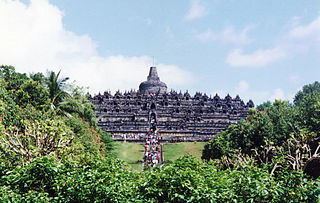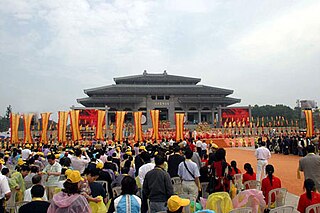
Taoism or Daoism is a diverse tradition indigenous to China, variously characterized as both a philosophy and a religion. Taoism emphasizes living in harmony with the Tao—generally understood as being the impersonal, enigmatic process of transformation ultimately underlying reality. The concept originates in the Chinese word 道, which has numerous related meanings: possible English translations include 'way', 'road', and 'technique'. Taoist thought has informed the development of various practices within the Taoist tradition and beyond, including forms of meditation, astrology, qigong, feng shui, and internal alchemy. A common goal of Taoist practice is self-cultivation resulting in a deeper appreciation of the Tao, and thus a more harmonious existence. There are different formulations of Taoist ethics, but there is generally emphasis on virtues such as effortless action, naturalness or spontaneity, simplicity, and the three treasures of compassion, frugality, and humility. Many Taoist terms lack simple definitions and have been translated in several different ways.

Religion in Japan is manifested primarily in Shinto and in Buddhism, the two main faiths, which Japanese people often practice simultaneously. According to estimates, as many as 80% of the populace follow Shinto rituals to some degree, worshiping ancestors and spirits at domestic altars and public shrines. An almost equally high number is reported as Buddhist. Syncretic combinations of both, known generally as shinbutsu-shūgō, are common; they represented Japan's dominant religion before the rise of State Shinto in the 19th century.

Religion in China is diverse and most Chinese people are either non-religious or practice a combination of Buddhism and Taoism with a Confucian worldview, which is collectively termed as Chinese folk religion.

Chinese folk religion, also known as Chinese popular religion, comprehends a range of traditional religious practices of Han Chinese, including the Chinese diaspora. Vivienne Wee described it as "an empty bowl, which can variously be filled with the contents of institutionalised religions such as Buddhism, Taoism, Confucianism and Chinese syncretic religions". This includes the veneration of shen (spirits) and ancestors. Worship is devoted to deities and immortals, who can be deities of places or natural phenomena, of human behaviour, or founders of family lineages. Stories of these gods are collected into the body of Chinese mythology. By the Song dynasty (960–1279), these practices had been blended with Buddhist, Confucian, and Taoist teachings to form the popular religious system which has lasted in many ways until the present day. The present day government of mainland China, like the imperial dynasties, tolerates popular religious organizations if they bolster social stability but suppresses or persecutes those that they fear would undermine it.

Asian witchcraft encompasses various types of witchcraft practices across Asia. In ancient times, magic played a significant role in societies such as ancient Egypt and Babylonia, as evidenced by historical records. In the Middle East, references to magic can be found in the Torah and the Quran, where witchcraft is condemned due to its association with belief in magic, as it is within other Abrahamic religions.

The Eastern religions are the religions which originated in East, South and Southeast Asia and thus have dissimilarities with Western, African and Iranian religions. Eastern religions include:

Kejawèn, Kejawan, or Kajawan is one of the two Javanism folk religious denominations, alongwith Kapitayan. In Kejawèn Javanism, the form of spiritual polytheistic worship is apparent.

The beliefs and practices of African people are highly diverse, including various ethnic religions. Generally, these traditions are oral rather than scriptural and are passed down from one generation to another through folk tales, songs, and festivals, and include beliefs in spirits and higher and lower gods, sometimes including a supreme being, as well as the veneration of the dead, and use of magic and traditional African medicine. Most religions can be described as animistic with various polytheistic and pantheistic aspects. The role of humanity is generally seen as one of harmonizing nature with the supernatural.

Buddhism's rich history spans over 2,500 years, originating from the Indian subcontinent in the 2nd century AD. Teachings of the Buddha were introduced over time, as a response to brahmanical teachings. Buddhism relies on the continual analysis of the self, rather than being defined by a ritualistic system, or singular set of beliefs. The intersections of Buddhism with other Eastern religions, such as Taoism, Shinto, Hinduism, and Bon illustrate the interconnected ideologies that interplay along the path of enlightenment. Buddhism and eastern religions tend to share the world-view that all sentient beings are subject to a cycle of rebirth that has no clear end.
Asia is the largest and most populous continent and the birthplace of many religions including Buddhism, Christianity, Confucianism, Hinduism, Islam, Jainism, Judaism, Shinto, Sikhism, Taoism, and Zoroastrianism. All major religious traditions are practiced in the region and new forms are constantly emerging. Asia is noted for its diversity of culture. Islam and Hinduisms are the largest religion in Asia with approximately 1.2-1.3 billion adherents each.

Taoism or "Do" is thought to be the earliest state philosophy for the Korean people. However, its influence waned with the introduction of Buddhism during the Goryeo kingdom as the national religion and the dominance of neo-Confucianism during the Joseon dynasty. Despite its diminished influence during those periods, it permeated all strata of the Korean populace, integrating with its native animism as well as Buddhist and Confucian institutions, temples, and ceremonies. The Taoist practice in Korea developed, somewhat in contrast to China, as an esoteric meditative practice in the mountains taught by the "mountain masters" or "mountain sages".

Religion in Taiwan is characterised by a diversity of religious beliefs and practices, predominantly those pertaining to the continued preservation of the ancient Chinese culture and religion. Freedom of religion is inscribed in the constitution of the Republic of China (Taiwan). The majority of Taiwanese people practice a combination of Buddhism and Taoism often with a Confucian worldview, which is collectively termed as Chinese folk religion.

In the study of comparative religion, the East Asian religions or Taoic religions, form a subset of the Eastern religions. This group includes Chinese religion overall, which further includes ancestor veneration, Chinese folk religion, Confucianism, Taoism and popular salvationist organisations, as well as elements drawn from Mahayana Buddhism that form the core of Chinese and East Asian Buddhism at large. The group also includes Japanese Shinto, Tenrikyo, and Korean Muism, all of which combine Shamanistic elements and indigenous ancestral worship with various influences from Chinese religions. Chinese salvationist religions have influenced the rise of Japanese new religions such Tenriism and Korean Jeungsanism; as these new religious movements draw upon indigenous traditions but are heavily influenced by Chinese philosophy and theology. All these religious traditions generally share core concepts of spirituality, divinity and world order, including Tao ('way') and Tian ('heaven').

Malaysian folk religion refers to the animistic and polytheistic beliefs and practices that are still held by many in the Islamic-majority country of Malaysia. Folk religion in Malaysia is practised either openly or covertly depending on the type of rituals performed.

Theravada Buddhism is the largest and dominant religion in Laos. Theravada Buddhism is central to Lao cultural identity. The national symbol of Laos is the That Luang stupa, a stupa with a pyramidal base capped by the representation of a closed lotus blossom which was built to protect relics of the Buddha. It is practiced by 66% of the population. Almost all ethnic or "lowland" Lao are followers of Theravada Buddhism; however, they constitute only 40-50% of the population. The remainder of the population belongs to at least 48 distinct ethnic minority groups. Most of these ethnic groups are practitioners of Tai folk religions, with beliefs that vary greatly among groups.
In religious studies and folkloristics, folk religion, popular religion, traditional religion, or vernacular religion comprises various forms and expressions of religion that are distinct from the official doctrines and practices of organized religion. The precise definition of folk religion varies among scholars. Sometimes also termed popular belief, it consists of ethnic or regional religious customs under the umbrella of a religion; but outside official doctrine and practices.

Northeast China folk religion is the variety of Chinese folk religion of northeast China, characterised by distinctive cults original to Hebei and Shandong, transplanted and adapted by the Han Chinese settlers of Liaoning, Jilin and Heilongjiang since the Qing dynasty. It is characterised by terminology, deities and practices that are different from those of central and southern Chinese folk religion. Many of these patterns derive from the interaction of Han religion with Manchu shamanism.

Religion in Inner Mongolia is characterised by the diverse traditions of Mongolian-Tibetan Buddhism, Chinese Buddhism, the Chinese traditional religion including the traditional Chinese ancestral religion, Taoism, Confucianism and folk religious sects, and the Mongolian native religion. The region is inhabited by a majority of Han Chinese and a substantial minority of Southern Mongols, so that some religions follow ethnic lines.

Religious Confucianism is an interpretation of Confucianism as a religion. It originated in the time of Confucius with his defense of traditional religious institutions of his time such as the Jongmyo rites, and the ritual and music system.
















